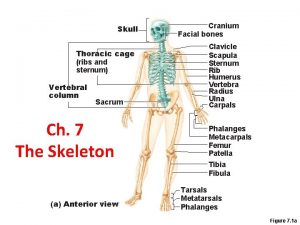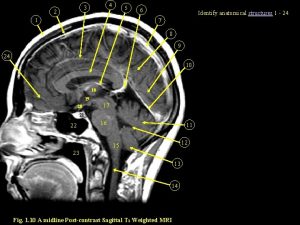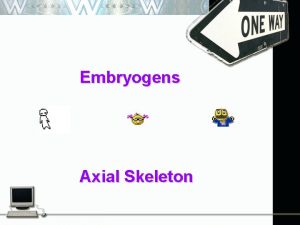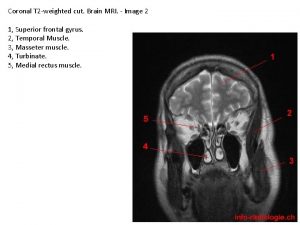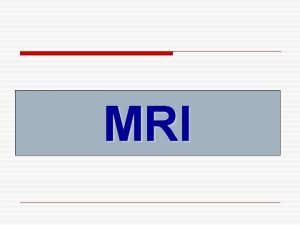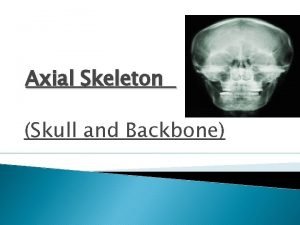Axial Coronal These are T 1 weighted MRI




















- Slides: 20

Axial Coronal These are T 1 weighted MRI images through the lower thigh, note the coronal reference image and the corresponding axial image These are the quadriceps Can you identify the muscle group muscles, what 4 muscles make up marked by the arrows? this group and what is the only Vastus medialis, lateralis and intermedius one of this groups that crosses 2 and the rectus femoris (rectus crosses joints? knee & hip joints)

What is the structure in the center of the muscle? (dark on outside bright in the center) This is the femur, so why is it dark on the outside and bright on the inside? Cortical bone, black signal, is very densely packed and generates almost no signal on MRI. The marrow space is filled with fat and marrow producing elements and is similar signal to the rest of the fat on MRI images.

Add mag N Hamstrings What is this vascular structure in the medial aspect of the thigh? Femoral artery What muscle overlies the femoral artery in the thigh? Sartorius Muscle What nerve lies between the adductor magnus and the hamstrings? Sciatic nerve


This axial slice is a little lower down. Can you name the vascular structures posterior to the femur? These are the popliteal artery and vein. What are the nerves just lateral and posterior to the vessels? Tibial nerve (solid arrow) Common peroneal nerve (dashed arrow)

Why does the femur have less black (cortex) and more medullary space (marrow fat) down close to the knee joint? This is because we have left the diaphysis and are now in the metaphysis where there is more marrow and cortex is thinner. Look at the cortical thickness

Let’s name some muscles. Can you point out the vastus medialis? Sartorius Semimembranosis Semitendinosis, just a tendon at this level Gracilis, it is just a tendon here Biceps femoris

These are some more inferior images of the knee, other side (left) from the previous patient. Can you follow the popliteal artery and vein and note their relationship to the nerves (tibial and peroneal together at this level). A V N


Can you identify the bone anterior to the femur. This is the patella. Note that the peroneal nerve is starting to head lateral at this level

Note how the muscles change around the knee. The semitendinosis and the gracilis are just tendons (black dots) at this level. Semitendinosis Gracilis

Look at the superficial peroneal nerve at the level. Where is it heading?


Why don’t we see any bones on this image? Because we are at the level of the knee joint

We are now below the level of the knee joint. What bone are we looking at? This is the tibia. Where is the fibula? B

What is this black structure attaching to the tibial tubercle? This is the patellar tendon. Do you see the fibula now?

What are the muscles you see in the upper calf posteriorly? Medial and lateral gastocnemius muscles. This is the solues muscle Popliteus


On this CT angiogram can you identify the popliteal artery, take-off of the anterior tibial artery, peroneal artery and posterior tibial artery? Popliteal arteries Anterior tibial arteries Peroneal arteries Posterior tibial arteries

This is a patient with complete disruption of the distal superficial femoral artery/upper popliteal artery. You can see how it is reconsitiuted (through collaterals) at the level of the knee joint. Disrupted Reconstituted
 Insidan region jh
Insidan region jh Hypothalamus mri coronal
Hypothalamus mri coronal Transverse plane definition anatomy
Transverse plane definition anatomy Weighted code in digital electronics
Weighted code in digital electronics Examples of axial movements
Examples of axial movements Copyright
Copyright Process of temporal bone
Process of temporal bone Coronal approach
Coronal approach Coronal
Coronal Coronal cut of sheep heart
Coronal cut of sheep heart Prontaion
Prontaion Deer medulla pattern
Deer medulla pattern Hair cuticle patterns
Hair cuticle patterns What makes hair evidence valuable
What makes hair evidence valuable How to tell human hair from animal hair
How to tell human hair from animal hair Onset coda nucleus
Onset coda nucleus Coronal vs sagittal
Coronal vs sagittal Mammillary body coronal
Mammillary body coronal Coronal section ct
Coronal section ct Horizontal
Horizontal Tooth tissue borne rpd
Tooth tissue borne rpd






